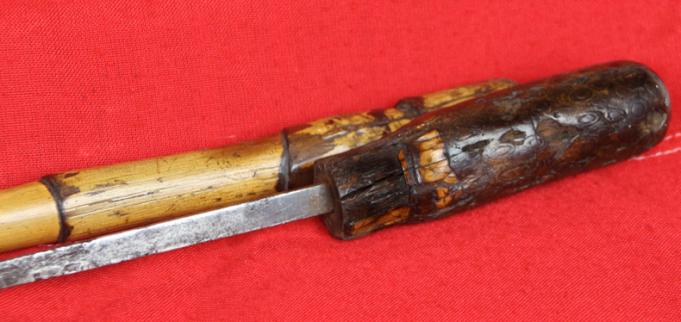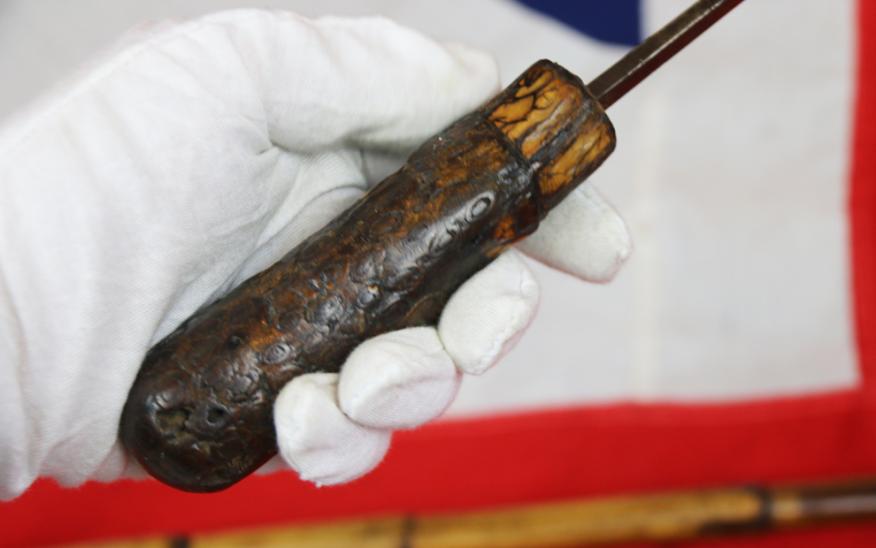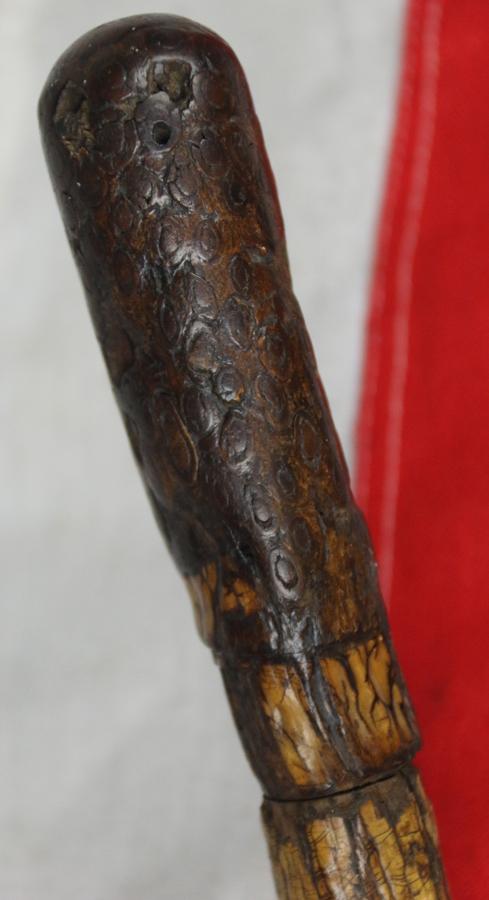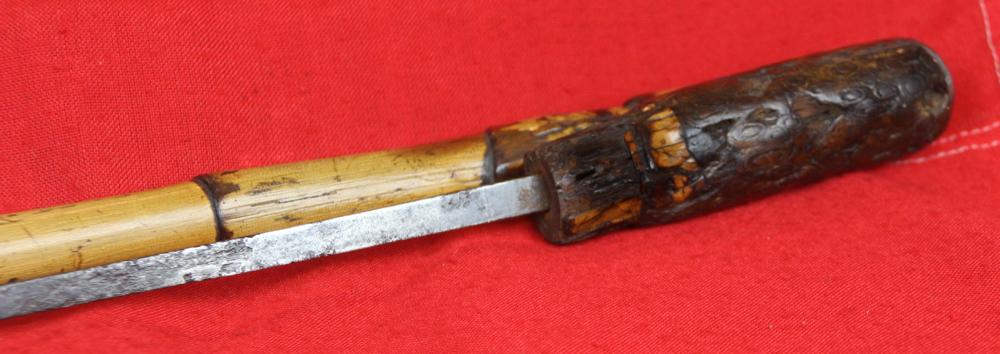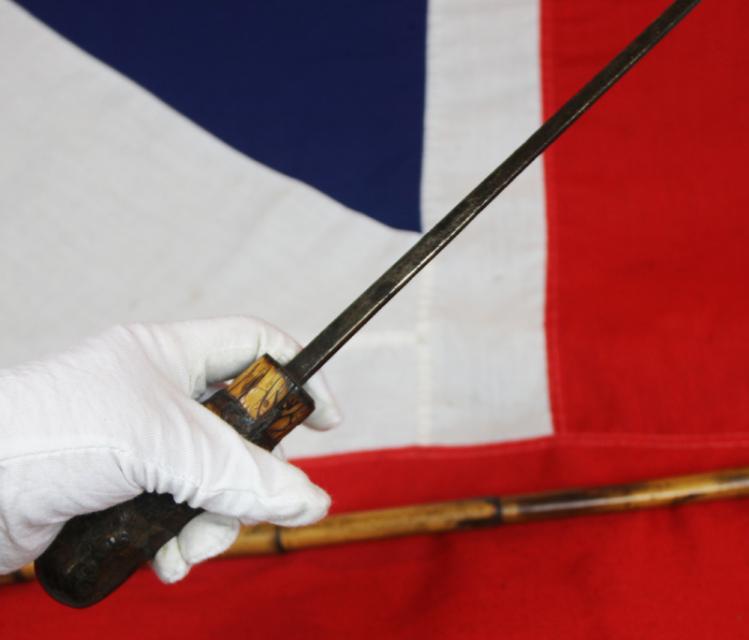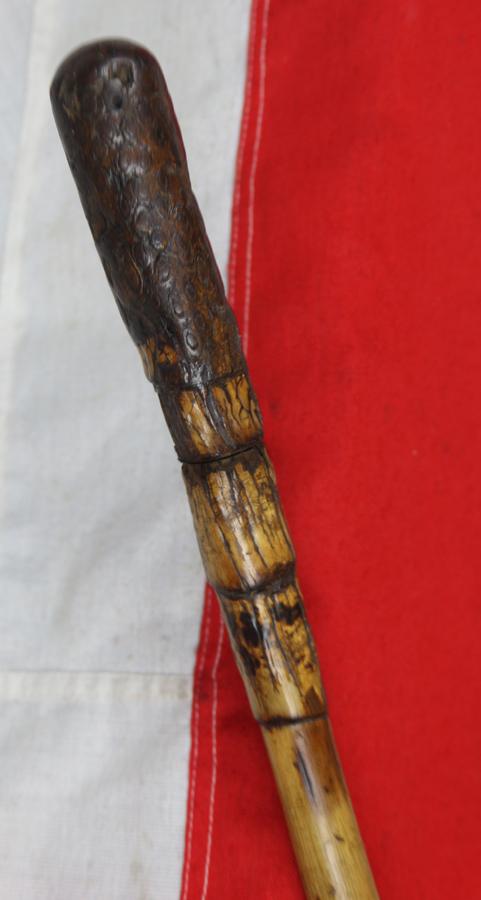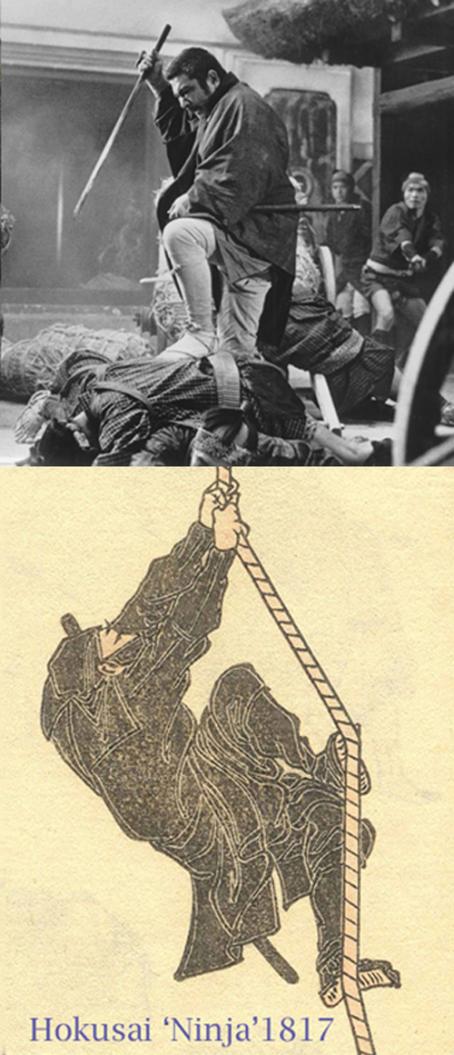A Good Antique Meiji Period Japanese Sword Stick 'Shikome Zue' In Bamboo
This is an antique Japanese sword stick called a shikomi-zue hidden sword. In the 1870's the Meiji Emperor disbanded the fuedal samurai order and banned the wearing of the sword. This created much unrest between the samurai and the government and some samurai moved to carrying shikome-zue hidden sword. Therefore, via a circuitous route, they still remain armed, but with their sword hidden from view. But by that way they felt, least in part, their honour remained intact. With a long and powerful blade. In ninjutsu shikomizue became quite popular, as it provided the night warriors with what they needed most – versatility, secrecy and mortality. The walking sticks were popular among all the classes and carrying it caused no suspicion. Combined with the impersonation skills, shikomizue was really a dangerous weapon attacking the enemy most suddenly. most effective tactical move by a man using a shikome-sue, would be to point or poke an assailant with the stick in its usual guise, the poked would then grab the haft and pull the stick in order disarm the stick from the owner, but the haft would pull away sharply, unsheathing the blade in the process for the holder, and the holder could then simply thrust forward into the assailants body, no doubt much to his shock and amazement and the entire mortal action would take under a second in skilled hands.
This is a fine antique Edo Japanese sword stick called a shikomi-zue hidden sword. Although used for centuries before they most came into popularity amongst disarmed samurai in the 1870's, when the Meiji Emperor disbanded the fuedal samurai by order, and disarmed the samurai class by banning the wearing of the sword.
This heinous event created much unrest between the samurai and the government and some samurai moved to carrying such shikome-zue hidden sword. Therefore, via a circuitous route, they still remain armed, but with their sword hidden from view. But by that way they felt, least in part, their honour remained intact, by still carrying a concealed long and powerful blade.
In ninjutsu, centuries before, shikomizue became quite popular, as it provided the night warriors with what they needed most – versatility, secrecy and mortality. By carrying a shikome-zue and wearing all black peasant like apparel the ninja could go about his craft in daylight apparently quite innocently and thus ignored. He could wander amongst the peasantry in a town village or city freely, making his task of surveillance or intelligence gathering far easier, yet still be armed with deadly intent. Innocent appearing regular and simple walking sticks were popular among all classes and thus by carrying it caused no suspicion at all. Combined with the impersonation skills, shikomizue was really a dangerous weapon giving the ninja the ability of attacking the enemy or assigned victim most suddenly, and incredibly effectively, with the ninja able to disappear as quickly as he had appeared.
The origin of the so-called ninjutsu;
Spying in Japan dates as far back as Prince Shotoku (572–622). According to Shoninki, the first open usage of ninjutsu during a military campaign was in the Genpei War, when Minamoto no Kuro Yoshitsune chose warriors to serve as shinobi during a battle. This manuscript goes on to say that during the Kenmu era, Kusunoki Masashige frequently used ninjutsu. According to footnotes in this manuscript, the Genpei War lasted from 1180 to 1185, and the Kenmu Restoration occurred between 1333 and 1336. Ninjutsu was developed by the samurai of the Nanboku-cho period, and further refined by groups of samurai mainly from Koka and the Iga Province of Japan in later periods.
Throughout history, the shinobi were assassins, scouts, and spies who were hired mostly by territorial lords known as daimyo. Despite being able to assassinate in stealth, the primary role was as spies and scouts. Shinobi are mainly noted for their use of stealth and deception. They would use this to avoid direct confrontation if possible, which enabled them to escape large groups of opposition.
Many different schools (ryū) have taught their unique versions of ninjutsu. An example of these is the Togakure-ryū, which claims to have been developed after a defeated samurai warrior called Daisuke Togakure escaped to the region of Iga. He later came in contact with the warrior-monk Kain Doshi, who taught him a new way of viewing life and the means of survival (ninjutsu).
Ninjutsu was developed as a collection of fundamental survivalist techniques in the warring state of feudal Japan. The ninja used their art to ensure their survival in a time of violent political turmoil. Ninjutsu included methods of gathering information and techniques of non-detection, avoidance, and misdirection. Ninjutsu involved training in what is called freerunning today, disguise, escape, concealment, archery, and medicine. Skills relating to espionage and assassination were highly useful to warring factions in feudal Japan. At some point, the skills of espionage became known collectively as ninjutsu, and the people who specialized in these tasks were called shinobi no mono.
There were no female ninja, however, the late 17th century the ninja handbook Bansenshukai describes a technique called kunoichi-no-jutsu (くノ一の術, "the ninjutsu of a woman") in which a woman is used for infiltration and information gathering, which Seiko Fujita considers evidence of female ninja activity
This is a good robust example, and would have been highly effective in its day. The blade is a long thrusting and parrying blade, without a dominant edge. The stick is fully bamboo with a bamboo root-ball handle. We show an 1817 Japanese print by Hokusai of his depiction of an all black clad warrior so called ninja climbing a rope, with what appears to be his shikome-zue hidden sword stick. Some shikome-zue have early smith made antique adapted blades from swords, this is a standard sword blade that was custom made for this cane when it was created, possibly in the 19th century or earlier. Overall grey steel with areas of pitting. 34.75 inches long overall, blade 28.25 inches
Code: 23479



